Uncover the symbolic chasms in the Bible, revealing deep divides that challenge our understanding of faith, morality, and the essence of separation.
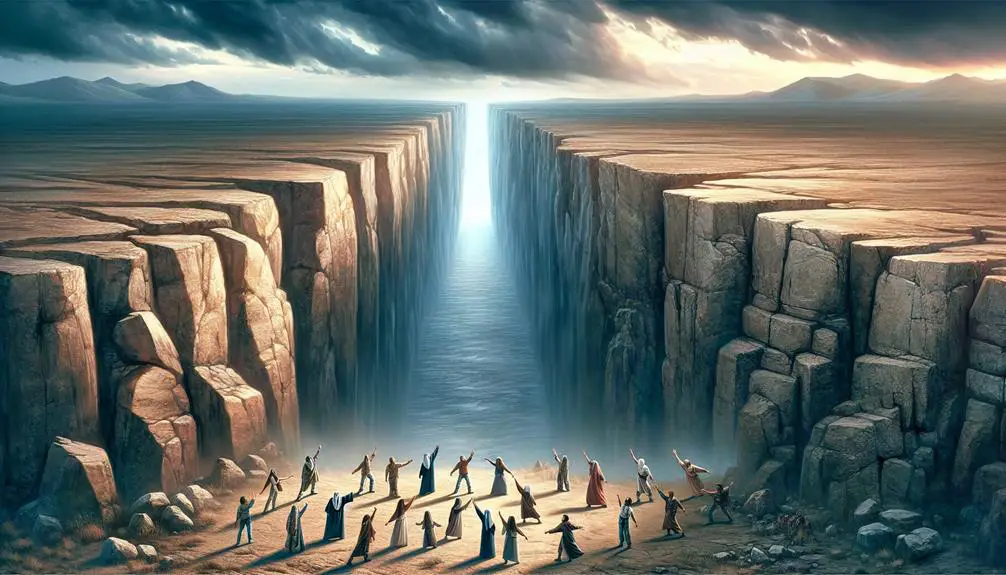
Chasm in the Bible
In the Bible, chasms both divide and define, offering a stark contrast between salvation and condemnation, unity and separation. You'll find these rifts not just in the physical landscapes, like the Red Sea parting for Moses, but also in the spiritual fabric of narratives, such as the parable of the Rich Man.
Each story uses the concept of a chasm to bridge profound theological insights, challenging you to reconsider the spaces between us, both seen and unseen. Let's explore together how these biblical chasms invite a deeper understanding of faith, morality, and the very nature of division itself.
Key Takeaways
- The chasm symbolizes the division between divine will and human defiance, as seen in Moses parting the Red Sea.
- It represents barriers to spiritual accessibility, highlighted by the tearing of the Temple Veil.
- The chasm reflects moral and spiritual divides, such as the gap between rich and poor in the Parable of the Rich Man.
- Peter's Vision illustrates the bridging of chasms between cultures, promoting inclusivity and the expansion of Christian community.
The Parable of the Rich Man

The Parable of the Rich Man, often cited for its profound insights into human morality and divine justice, serves as a compelling examination of wealth, compassion, and the afterlife within biblical teachings. You'll find that this narrative isn't just a story; it's a meticulously crafted lesson on the consequences of ignoring wealth disparity and the potential for afterlife justice to redress the imbalances of the earthly plane.
Analyzing this parable, you discern a clear depiction of opulence juxtaposed with destitution. The rich man lives in luxury every day, while Lazarus, a poor man, languishes at his gate, longing for scraps. This vivid portrayal of wealth disparity isn't merely historical; it's a mirror reflecting ongoing societal issues, pushing you to confront the moral implications of ignoring those in need.
Upon their deaths, the fortunes of the rich man and Lazarus invert in the afterlife, illustrating the concept of afterlife justice. Lazarus is comforted in Abraham's bosom, a metaphor for eternal peace, whereas the rich man suffers in Hades, yearning for a drop of water to cool his tongue. This reversal of fortunes underscores a divine principle: earthly actions have eternal consequences, particularly regarding the treatment of the poor and vulnerable.
This parable, therefore, isn't just a cautionary tale about the dangers of wealth and neglect of the poor; it's a profound exploration of divine justice. It challenges you to consider how wealth disparity is addressed in the afterlife, presenting a divine correction for earthly inequities. Through this narrative, you're invited to reflect on your own actions and their potential impact in the eternal scheme of things.
Moses and the Red Sea

Reflecting on the moral and divine implications of the afterlife as seen in the Parable of the Rich Man, we now turn our attention to another significant biblical event: Moses parting the Red Sea. This event, steeped in the miraculous crossing orchestrated by divine intervention, marks a pivotal moment in the exodus of the Israelites from Egypt. It's not just a tale of escape but a profound narrative on faith, obedience, and the lengths to which divine providence can alter the natural order for the fulfillment of its purposes.
You encounter in this narrative a stark demonstration of God's power and a test of faith for Moses and the Israelites. Pharaoh's pursuit adds a layer of urgency and drama, highlighting the stark contrasts between the oppressor's relentless tyranny and the oppressed's desperate hope for deliverance.
Consider these critical aspects of the event:
- Divine Intervention: The parting of the Red Sea is a prime example of God directly intervening in human history to guide and protect His chosen people.
- Test of Faith: The Israelites, faced with seemingly insurmountable obstacles, must place their trust wholly in Moses and, by extension, in God's promise and power.
- Pharaoh's Pursuit: This relentless chase underscores the enduring conflict between the divine will and human defiance, illustrating the eventual futility of opposing divine decrees.
Analyzing this event, you grasp not only its historical and religious significance but also its enduring lessons on faith, leadership, and the power of divine intervention. The miraculous crossing, underscored by Pharaoh's futile pursuit, remains a cornerstone of faith for many, symbolizing hope and deliverance against all odds.
The Walls of Jericho
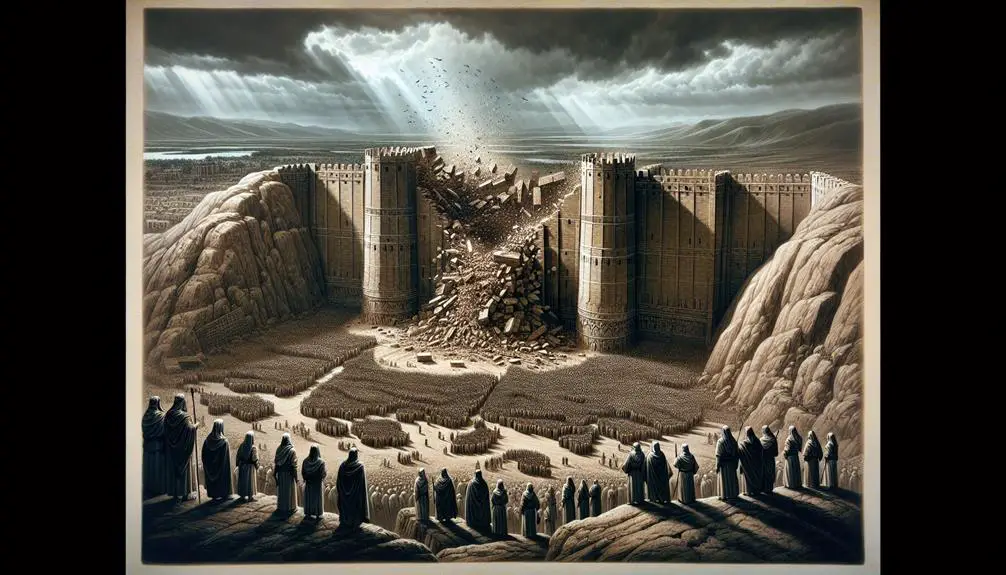
In the wake of Moses parting the Red Sea, another remarkable biblical event unfolds with the fall of the Walls of Jericho, embodying divine intervention's power in guiding the Israelites towards their promised destiny. This narrative, deeply embedded in historical and religious texts, showcases an intriguing intersection of faith, military tactics, and archaeological evidence, offering a multifaceted perspective on ancient warfare and divine guidance.
The biblical account describes the Israelites encircling Jericho for seven days, with the walls collapsing on the seventh day following the priests' trumpet blast. This story, while miraculous, prompts a deeper investigation into the possible convergence of divine act and military strategy.
Aspect |
Biblical Account |
Archaeological Evidence |
|---|---|---|
Strategy |
Encircling the city |
Limited evidence of siege |
Outcome |
Walls collapsed |
Layers of destruction |
Divine Intervention |
Trumpet blast caused collapse |
No direct evidence |
Military Tactics |
Psychological warfare |
Common in ancient sieges |
Historicity |
Miraculous event |
Debate among scholars |
Archaeological excavations at Jericho have revealed layers of destruction that some argue could correspond with the biblical timeline, albeit with considerable debate among scholars. While direct evidence of the walls' collapse in the manner described in the Bible remains elusive, the archaeological findings provide a tangible backdrop to the narrative, suggesting a complex interplay of natural and human-induced factors.
The analysis of the Walls of Jericho through the lenses of military tactics and archaeological evidence highlights the intricacies of interpreting ancient texts. It underscores the necessity of a multidisciplinary approach in unraveling the historical layers behind biblical narratives, bridging the gap between faith and empirical evidence.
The Splitting of the Temple Veil
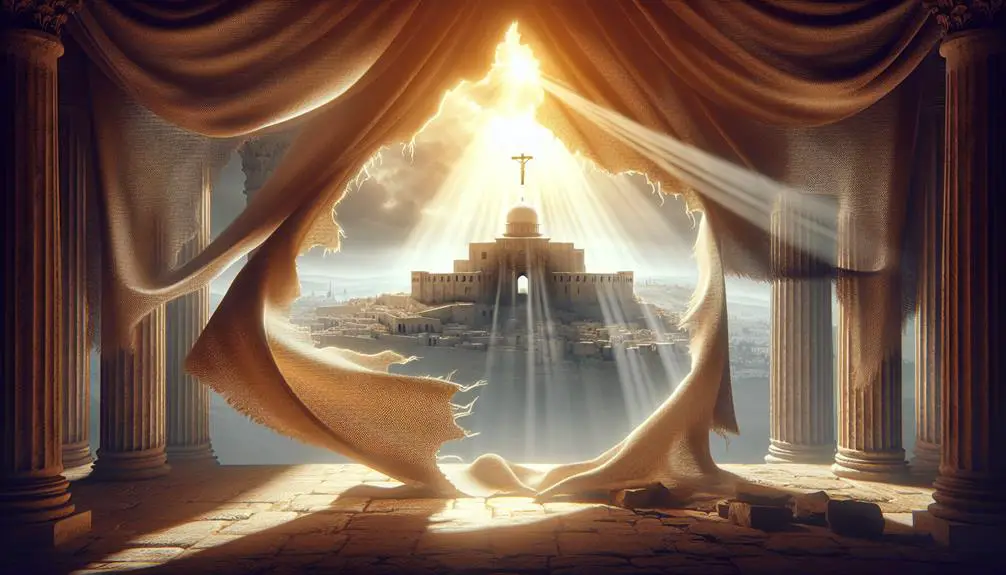
Shifting focus from ancient military marvels to significant religious phenomena, consider the moment when the Temple Veil split, a pivotal event symbolizing a new era in spiritual accessibility and divine revelation. This event, occurring at the crucifixion of Jesus Christ, is laden with profound symbolism and marks a transformative point in the relationship between humanity and the divine.
The Temple Veil, prior to its splitting, represented a barrier to the Holy of Holies, the most sacred part of the temple where God's presence was believed to dwell. Only the High Priest could enter, and then only once a year on Yom Kippur, to offer sacrifices for the sins of the people. The splitting of the veil tore down this barrier, symbolizing that through Christ's sacrifice, all people were granted direct access to God, without the need for an intermediary. This act of the veil tearing from top to bottom, as described in the Gospels, carries significant implications for the concept of sacred access and Veil symbolism in religious thought.
Key points to consider include:
- The veil's role as a physical and symbolic barrier between humanity and the divine
- The moment of the veil tearing signifying the removal of barriers to divine presence
- The implications for individual and communal religious experience and practice
Analyzing this event reveals its profound impact on theological concepts of redemption, atonement, and the nature of sacred spaces. The splitting of the Temple Veil not only redefined the parameters of sacred access but also emphasized the transformative power of divine intervention in bridging chasms between the divine and the mortal.
Peter's Vision of the Sheet
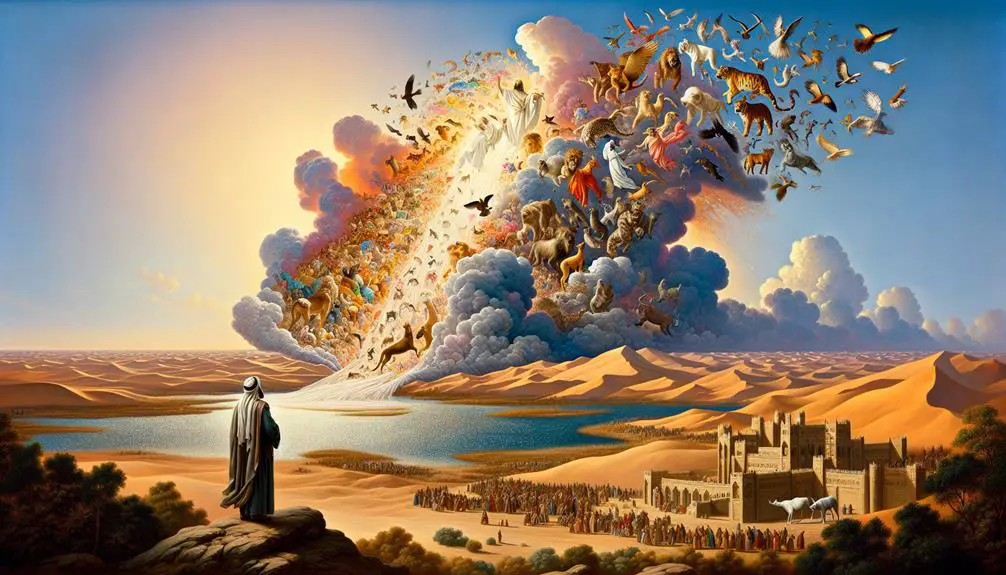
Peter's vision of the sheet, as recounted in the Acts of the Apostles, represents a pivotal moment in Christian theology, challenging existing dietary laws and expanding the scope of the nascent Church's mission. This vision, wherein a sheet full of unclean animals is lowered from heaven and Peter is instructed to eat, defies the strict dietary laws that had hitherto defined clean and unclean foods. The divine command, 'Do not call anything impure that God has made clean,' serves not only to overturn these dietary restrictions but also symbolizes a broader theological shift towards Gentile inclusion within the Christian community.
Analyzing this narrative, you'll find that the vision's significance extends beyond dietary laws, touching the very heart of early Christian identity and mission. It marks a transition from a sect within Judaism to a universal church, embracing all of humanity without regard to previous distinctions. The sheet, filled with animals previously considered unclean, symbolizes the inclusion of Gentiles, who were outside the covenant and considered impure according to Jewish law. This moment illustrates the early Church's grappling with its Jewish roots while navigating the inclusion of Gentile believers, a process that would shape its theological and social identity.
Furthermore, Peter's vision underscores the transformative power of divine revelation in redefining purity and community boundaries. It challenges believers to reconsider their understanding of God's will, pushing the Church towards a more inclusive interpretation of God's people. Through this vision, the Acts of the Apostles articulates a foundational principle for Christian theology: the universal availability of God's salvation, transcending previous barriers and embracing a diverse humanity.
Frequently Asked Questions
How Has the Concept of a Chasm Been Interpreted in Different Cultures and Religions Outside the Biblical Context?
You'll find that in various cultures and religions, the concept of a chasm has been interpreted as both mythological voids and cultural bridges. This symbolism explores the profound gaps between realms, ideas, or states of being, serving as metaphors for transformation, transition, or obstacles.
Across mythologies, these chasms often facilitate events of great change, embodying the physical and spiritual journeys that connect or separate worlds, ideologies, or phases of life.
What Are the Psychological Implications of the Chasm Imagery as Used in the Bible, Particularly in Shaping Believers' Perceptions of Separation and Unity?
You're exploring how chasm imagery impacts believers' psyche, shaping perceptions of separation and unity. This spiritual navigation fosters emotional resilience, as you delve into its psychological implications.
How Have Artists Throughout History Depicted Biblical Chasms, Such as the One in the Parable of the Rich Man and Lazarus, in Their Works?
Artists have used various mediums to explore chasm symbolism, capturing the essence of separation and moral lessons. They've painted, sculpted, and etched, using contrasts of light and shadow to emphasize the divide.
Whether in Renaissance frescoes or modern installations, these depictions invite reflection on spiritual and ethical divides. This artistic exploration offers a visual interpretation that complements textual narratives, enriching your understanding of themes like redemption and judgment.
In What Ways Has Modern Theology Challenged or Reinterpreted the Traditional Understanding of Chasms Mentioned in the Bible?
Modern theology has often reexamined traditional biblical interpretations, including those of chasms. Theologians have delved into chasm metaphors, suggesting they're not just physical separations but also symbolize deeper spiritual or societal divides.
Through theological revisions, you'll find a shift towards understanding these chasms as calls for empathy and bridging gaps among people. This perspective challenges older views by emphasizing inclusivity and the breaking down of barriers that separate individuals.
Can the Concept of a Chasm in the Bible Be Related to Contemporary Environmental Issues, Such as the Divide Between Humanity and Nature?
Certainly, you can link the biblical concept of chasms to today's environmental crises, such as the widening gap between humanity and nature. Take, for instance, the economic inequality and technological gaps exacerbating climate change, much like a chasm. These disparities prevent effective action against environmental degradation, reflecting a modern-day chasm between human progress and the natural world's wellbeing, calling for a bridging of this divide to ensure a sustainable future.
Conclusion
In analyzing biblical chasms, you've journeyed through narratives of division and revelation, from the literal to the metaphorical. These chasms, whether it's the Red Sea parting or the Temple veil tearing, symbolize transformative points in biblical history.
The use of a metaphorical 'internet divide' reflects today's challenges in bridging gaps in understanding and belief. Each story invites you to reflect on the barriers in your life and the potential for breakthroughs, echoing timeless struggles and aspirations.


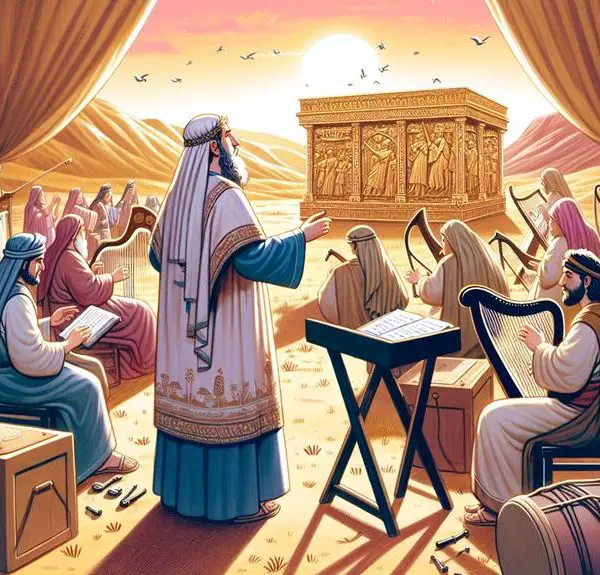
Sign up